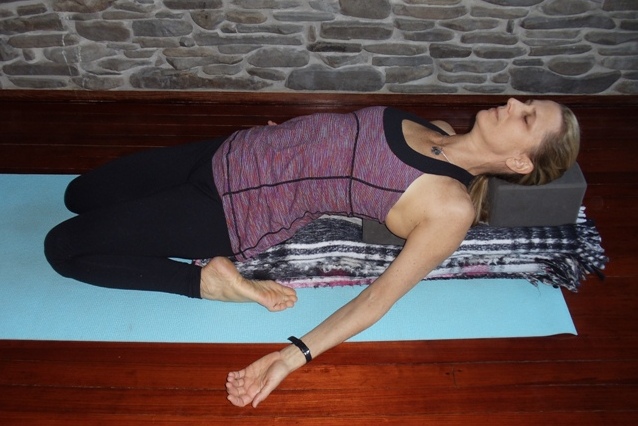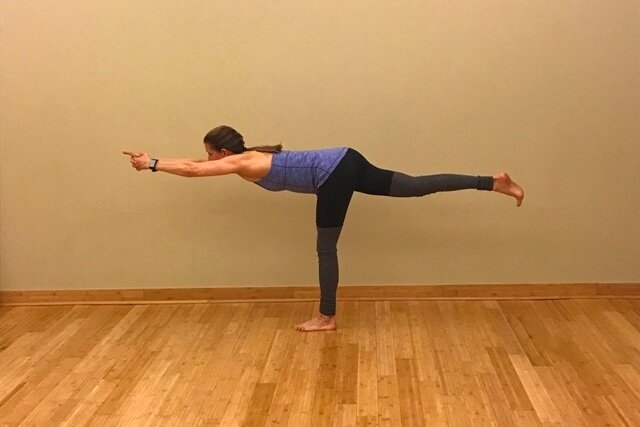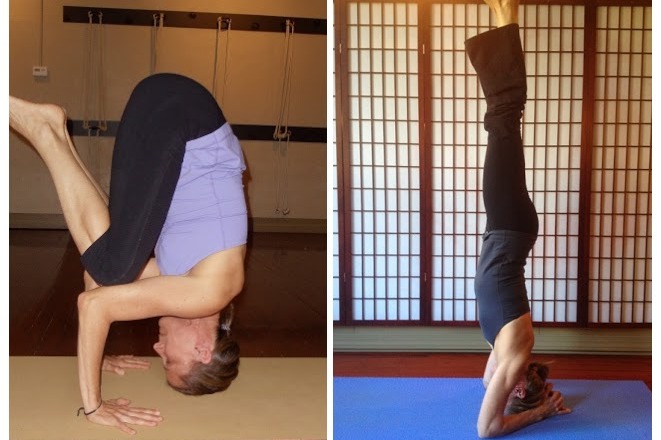Sarvangasana or Shoulder Stand
Shoulder Stand is a posture that is not often taught in yoga classes. To do it properly and safely requires the use of props for most people. The way that I prop for Shoulder Stand follows a traditional Iyengar set-up; 2 to 3 blankets, a belt, a block and a mat for each person. A lot of studios simply do not have enough props. But, in addition, students have to be taught how to use the props and how to set them up precisely for maximum benefit. Unfortunately, I have been in many yoga studios where it is clear that students as well as teachers do not know how to properly fold a blanket or even buckle a belt. Also, many yogis often see props as a sign of inadequacy and their use as beneath them. I see props as an enhancement to my yoga practice, an assist when needed and as tools to teach the body optimum alignment.
Unfortunately, Shoulder Stand has a reputation for being a dangerous pose for people’s necks. If you ask someone to stand up straight and bend their head forward, you will see that no one’s neck can bend at 90 degrees. The normal range of neck flexion is 60 degrees. In order to do Shoulder Stand safely, the shoulders and upper arms must be lifted off of the floor sufficiently to allow the neck to bend at its’ comfortable limit. Doing Shoulder Stand without props can put undue force on someone’s cervical vertebrae and this could be injurious to the neck.
Often students ask why they should practice Shoulder Stand. It seems that they are asking why they should bother with all of the props. Shoulder Stand is considered the Queen of asanas and it has many benefits. It is an introspective posture, all you can see is yourself (you are not meant to turn your head); it is also cooling, nurturing and feminine in nature. If you read in Light on Yoga, Mr. Iyengar lists many benefits for Sarvangasana. He says:
“Sarvangasana is the mother of asanas. As a mother strives for harmony and happiness in the home, so this asana strives for the harmony and happiness of the human system. It is a panacea for most common ailments. There are several endocrine organs or ductless glands in the human system which bathe in blood, absorb the nutrients from the blood and secrete hormones for the proper functioning of a balanced and well developed body and brain. If the glands fail to function properly, the hormones are not produced as they should be and the body starts to deteriorate. Amazingly enough many of the asanas have a direct effect on the glands and help them to function properly. Sarvangasana does this for the thyroid and parathyroid glands which are situated in the neck region, since due to the firm chin lock their blood supply is increased. Further, since the body is inverted, the venous blood flows to the heart without any strain by force of gravity. Healthy blood is allowed to circulate around the neck and chest. As a result, persons suffering from breathlessness, palpitation, asthma, bronchitis and throat ailments get relief. As the head remains firm in this inverted position, and the supply of blood to it is regulated by the firm chin lock the nerves are soothed and headaches, even chronic ones, disappear. Continued practice of this asana eradicates common colds and other nasal disturbances. Due to the soothing effect of the pose on the nerves, those suffering from hypertension, irritation, shortness of temper, nervous breakdown and insomnia are relieved. The change in bodily gravity also effects the abdominal organs so that the bowels move freely and constipation vanishes. As a result the system is freed from toxins and one feels full of energy. The asana is recommended for urinary disorders and uterine displacement, menstrual trouble, hemorrhoids and hernia. It also helps relieve epilepsy, low vitality and anemia. It is no over statement to say that if one practices Sarvangasana they will feel new vigour and strength and will be happy and confident. New life will flow into the body, the mind will be at peace and the practitioner will feel the joy of life. After a long illness, the practice of this asana regularly, twice a day, brings back lost vitality.”
We will work on Shoulder Stand this month and then next month we will work on Head Stand. Since these two poses are meant to be practiced together, as counter poses to each other, we will continue to include Shoulder Stand in our practice. According to the Iyengar tradition, you can practice Shoulder Stand by itself, but if you practice Head Stand, you should finish your practice with Shoulder Stand.














